Preface
Goal: A simple case example of concurrency using Python.
Preface
Goal: Continue Part Two
7: Approach in Solving Unique
A custom example, that you can rewrite.
An Algorithm Case
Why reinvent the wheel?
My intention is writing a custom pattern matching example, so later I can rewrite other algorithm based on this example. You can read the detail on the first article. The record overview.
Consider going back to simple data. We need to discuss about solving unique list.
x:xs Pattern Matching
The original x:xs pattern matching is made of two functions:
- Exclude
- Unique
Pattern matching in Python,
is not as fancy as haskell, or even OCaml.
But what we have in Python is enough,
to solve our little problem.
Exclude Function
The exclude function is just a filter with below details:
tags = ['60s', 'jazz', '60s', 'rock',
'70s', 'rock', '70s', 'pop']
def exclude(val, tags):
return [tag for tag in tags if tag != val]
print(exclude('rock', tags))With the result as below array:
❯ python 21-exclude.py
['60s', 'jazz', '60s', '70s', '70s', 'pop']
Recursive Unique Function
With exclude function above,
we can build unique function recursively, as below code:
from MySongs import songs
tags = ['60s', 'jazz', '60s', 'rock',
'70s', 'rock', '70s', 'pop']
def exclude(val, tags):
return [tag for tag in tags if tag != val]
def unique(tags):
if len(tags) <= 1: return tags
else:
head, *tail = tags
return [head] + unique(exclude(head, tail))
print(unique(tags))- Although the syntax looks is, not exactly the same as functional programming in haskell, the algorithm is the same.
With the result as below array:
❯ python 22-unique-a.py
['60s', 'jazz', 'rock', '70s', 'pop']Now we can apply the method to our unique song challenge.
from MySongs import songs
tags = [
tag for song in songs
if 'tags' in song
for tag in song['tags']
]
def exclude(val, tags):
return [tag for tag in tags if tag != val]
def unique(tags):
if len(tags) <= 1: return tags
else:
head, *tail = tags
return [head] + unique(exclude(head, tail))
print(unique(tags))- With the same result as below
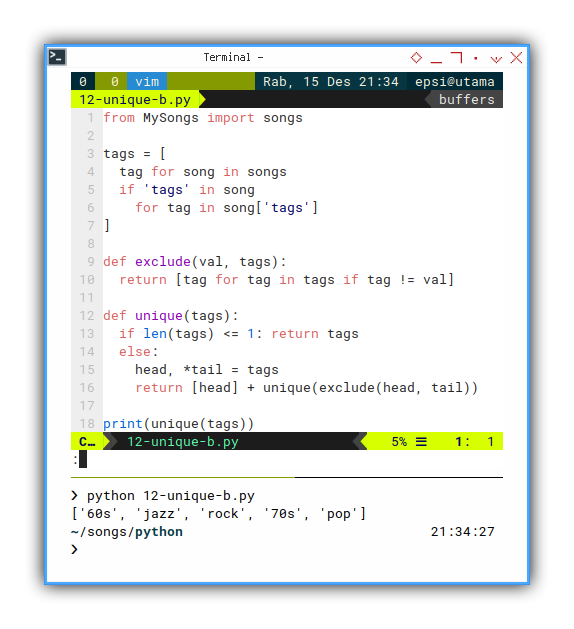
❯ python 22-unique-b.py
['60s', 'jazz', 'rock', '70s', 'pop']8: Generator
Yield
With imperative approach, we can also flatten tags.
We are going to consider this approach for concurrency topic.
Yield
Consider this function.
def sender(songs):
for song in songs:
if 'tags' in song:
for tag in song['tags']:
yield tagEntry Point
Then we can call later:
# main: entry point
from pprint import pprint
from MySongs import songs
pprint(list(sender(songs)))With the result of
❯ python 24-generator.py
['60s', 'jazz', '60s', 'rock', '70s', 'rock', '70s', 'pop']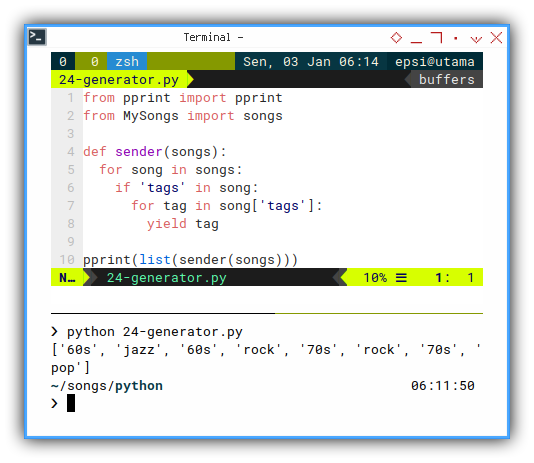
The Skeleton
With above code, we can build the basic of sender receiver function.
def receiver():
# ...
def sender():
# ...
# main: entry point
...Sender
Yield
It is very similar to our previous function,
but we add None value as a stopper.
def sender(songs):
for song in songs:
if 'tags' in song:
for tag in song['tags']:
yield tag
yield None
This None value is yielded outside the loop.
Receiver
Next
Now we can build a while loop that will stop,
whenever the value is None.
The next function will resume any yielded value,
one value for each next call.
def receiver(mygenr):
tags = []
while True:
item = next(mygenr)
if item is None:
return tags
else:
if not (item in tags):
tags.append(item)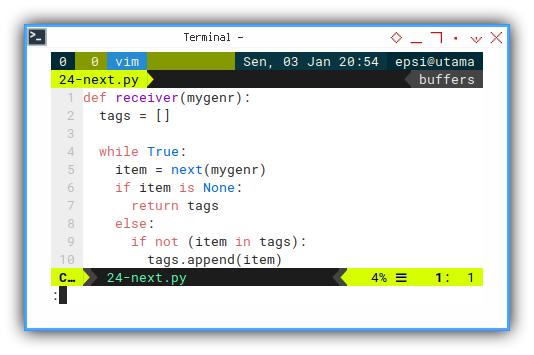
We also test for unique value before appending to tags array.
Main
And finally run both function.
# main: entry point
from pprint import pprint
from MySongs import songs
mygenr = sender(songs)
pprint(receiver(mygenr))With the result as below:
❯ python 24-next.py
['60s', 'jazz', 'rock', '70s', 'pop']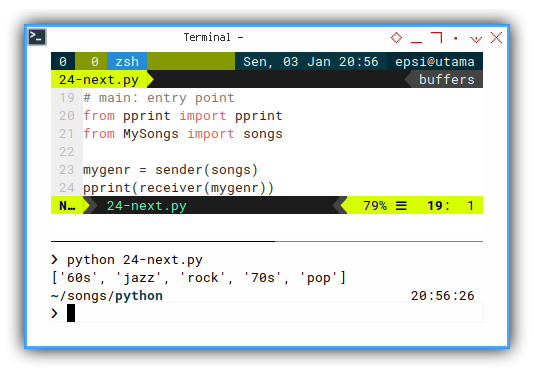
Now we can have unique tags, with very different approach, compare with our previous list comprehension.
9: Concurrency with Queue
Python support Actor Model pattern.
We can rewrite previous process through queue.
Reference
The Skeleton
We should be ready for the real demo. This is only consist of one short file.
import threading, queue
from MySongs import songs
q = queue.Queue()
tags = []
def receiver():
# ...
def sender():
# ...
threading.Thread(
target=receiver, daemon=True
).start()
sender()
q.join()- Producer: sender()
- Consumer: receiver()
- Program entry point: main()
Producer and Consumer
We should prepare two functions:
- One for
Producerthatputtoqueue, - And the other one for
Consumerthatgetfromqueue.
Producerthatputtoqueue.
def sender():
for song in songs:
if 'tags' in song:
for tag in song['tags']:
q.put(tag)
q.put(None)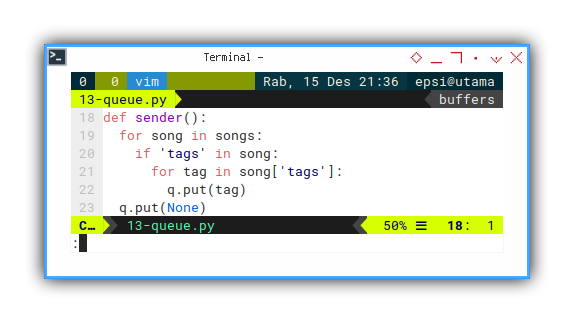
Consumerthatgetfromqueue.
def receiver():
while True:
item = q.get()
if item is None:
q.task_done()
break
else:
if not (item in tags):
tags.append(item)
q.task_done()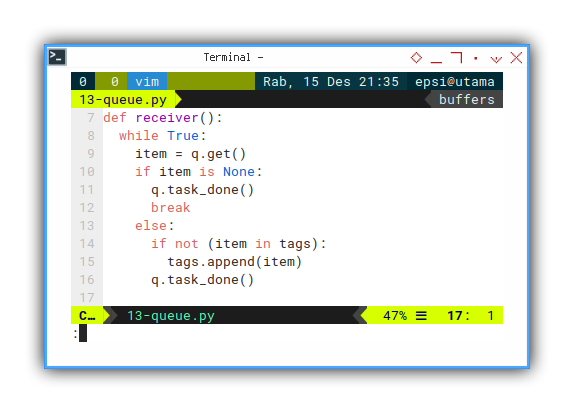
Running Both Routine
Pretty short right!
Consider gather both function in main entry point.
def main():
# turn-on the worker thread
threading.Thread(
target=receiver, daemon=True
).start()
# block until all tasks are done
sender()
q.join()
print(tags)
main()With the result as below array:
❯ python 23-queue.py
['60s', 'jazz', 'rock', '70s', 'pop']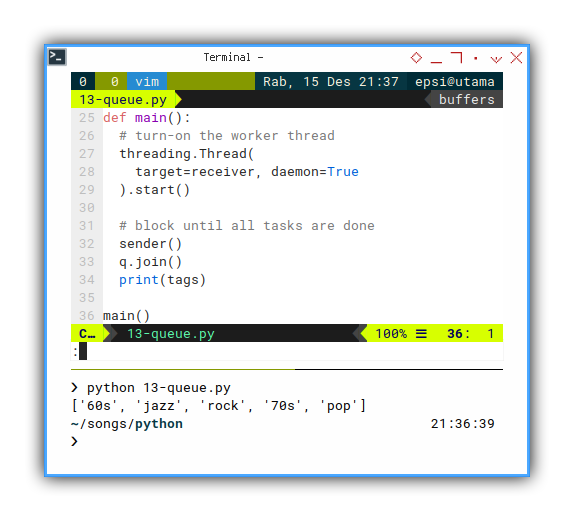
This is the end of our python journey in this article.
We shall meet again in other article.
What is Next 🤔?
Consider continue reading [ Ruby - Playing with Records - Part One ].